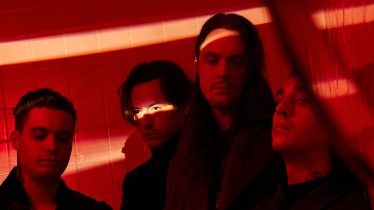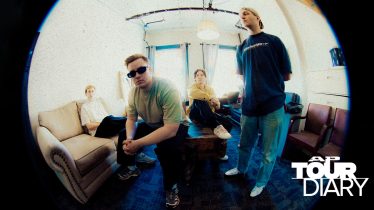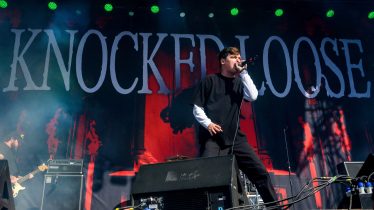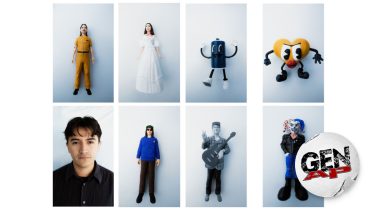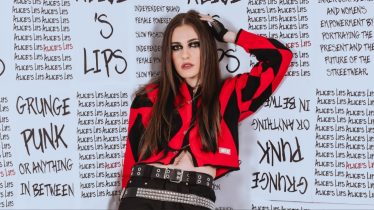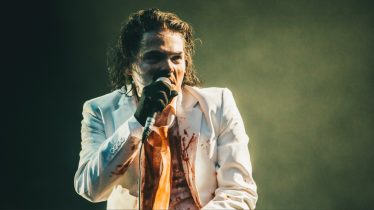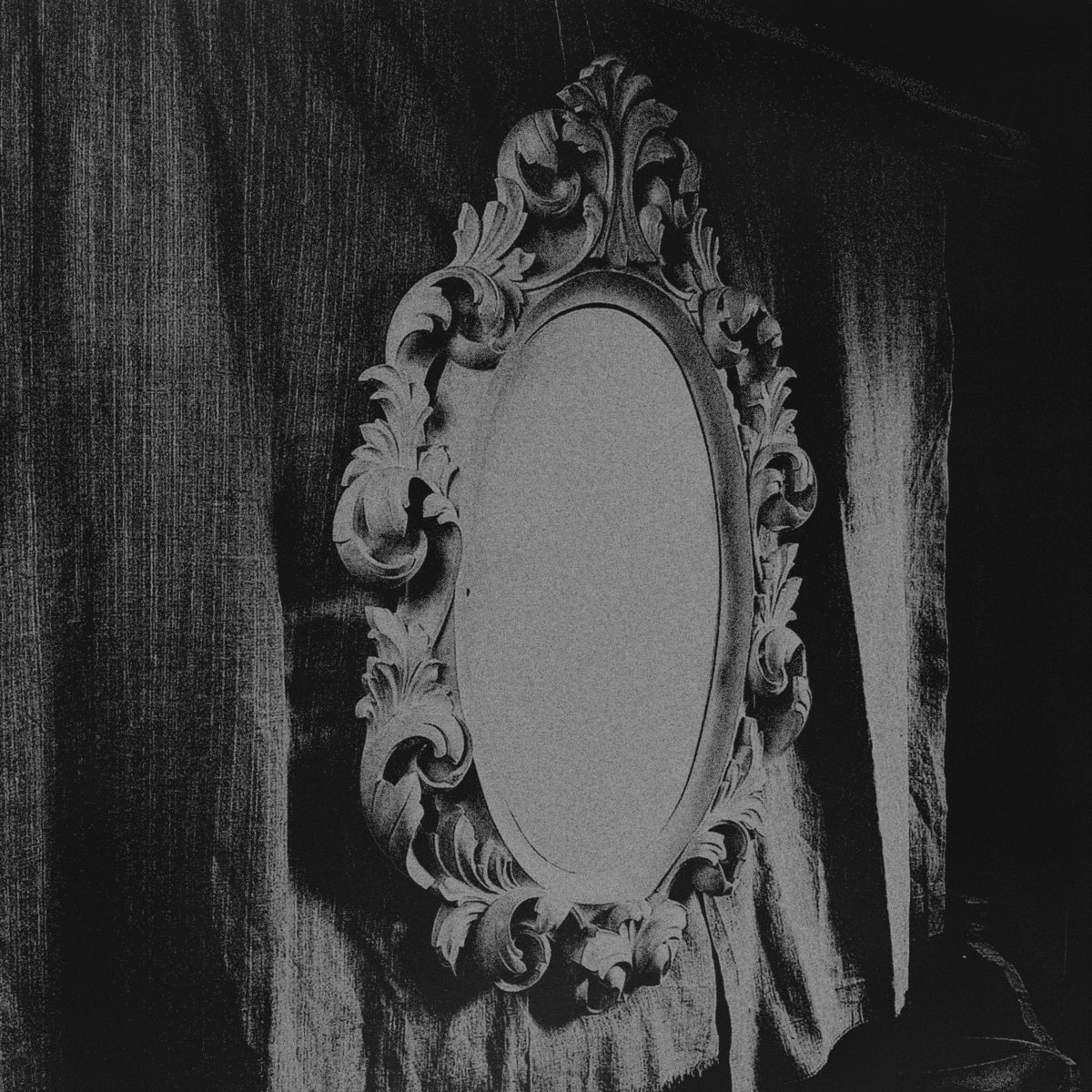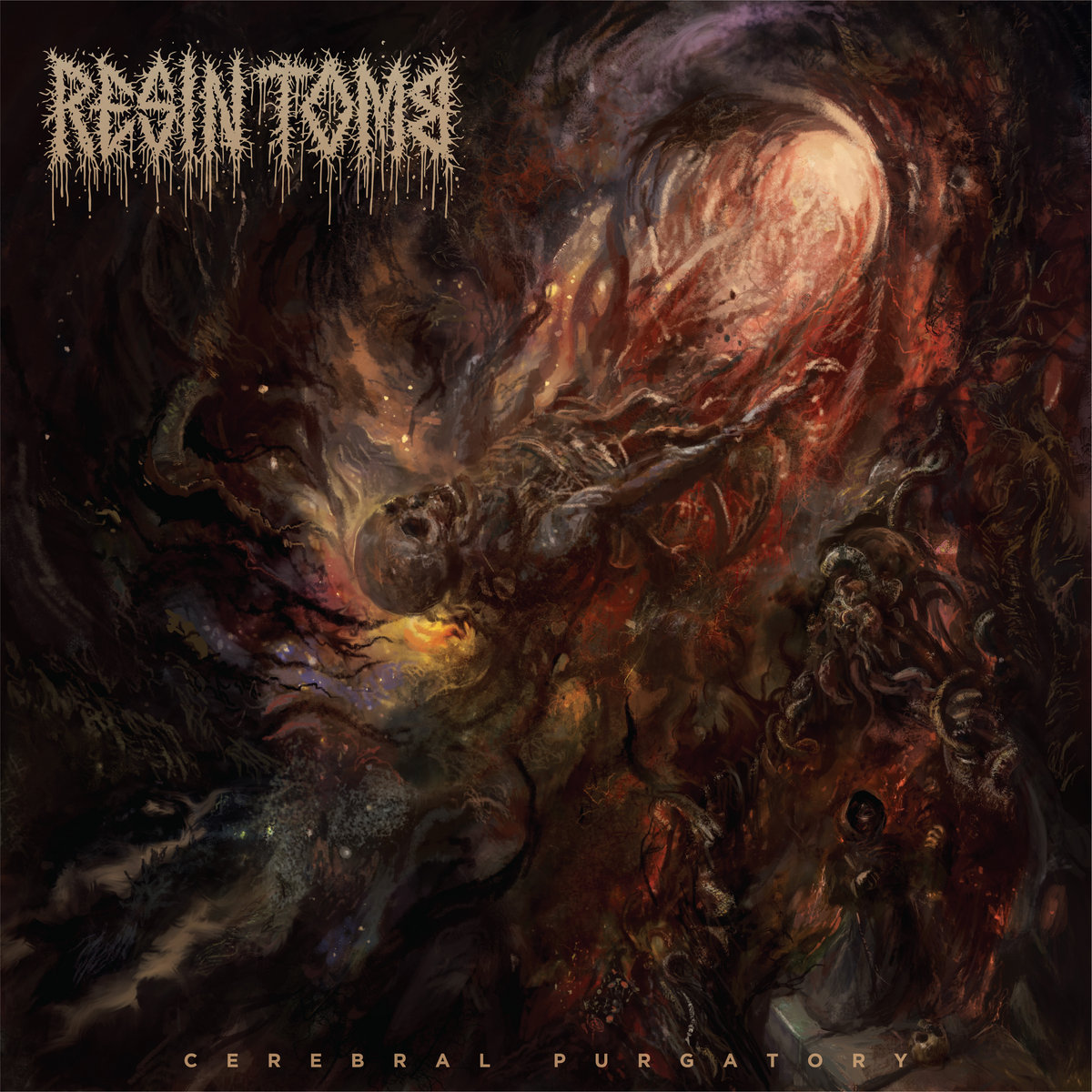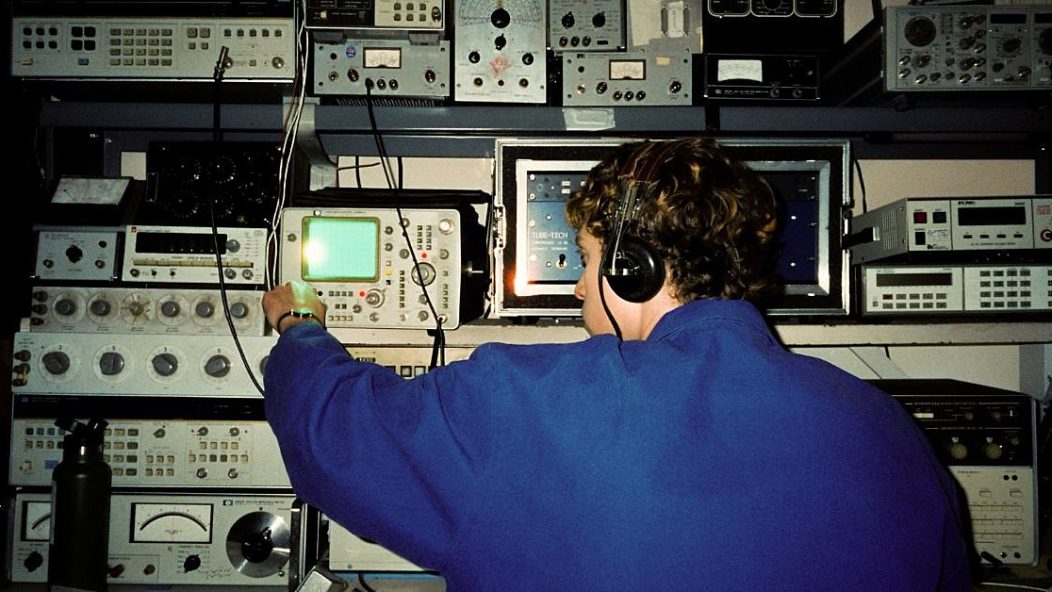
Hamond’s new project ‘Pirate Radio’ is a “friend and family affair”
Hamond is sitting at the booth, nodding his head to a foggy beat as the feds inevitably close in on his pirate radio broadcast. Then he pulls the mic close, stacks of vintage equipment sitting behind him, as he launches into “Left Feet” off Pirate Radio, out today via No Matter.
Hamond’s love of cinema is clear from the jump. Within seconds of viewing his stunning music video for “Left Feet,” it’s as if you’ve been dropped straight into a Wes Anderson film. While there are no dysfunctional families or quirky love stories, there’s a similar type of magic that permeates its two-and-a-half-minute runtime. The atmosphere feels surreal and offbeat, almost eerie; listeners question reality as they witness Hamond being watched from a two-way mirror — a reference to 1984 cult film Paris, Texas — as a mysterious woman stakes out his illegal operations from the other side.
Read more: How PinkPantheress uses 2000s nostalgia to craft a sound both familiar and fresh
The Houston artist tries to watch movies as often as he can. Lately he’s been in a Joaquin Phoenix mood, watching both Her and C’mon C’mon within days of each other. “Maybe Joker tonight,” he suggests. He’s even seen The Batman three times now. Hamond first saw the three-hour epic in theaters and has since put it on in the background as he’s working as something to aspire to.
But Pirate Radio is its own milestone. Two years in the making, Hamond is ready to unveil his 10-song collection to the world. Traversing pop, alternative, R&B and electronic music, the tracks all hold a cinematic throughline, with some paying homage to his Texas roots while others represent his new life in LA. “It’s crazy seeing something that I just made in the past month alongside something from two years ago, but they’re all in the same world,” he explains. “It’s like this era of my life that is coming to a close as it releases in a weird way. Then I get to see it take on a new life when other people get to hear it and form their opinions.”
One thing that popped out to me as I was listening to Pirate Radio is that all the songs feel so meticulously made. I even noticed the project name appears when you look up at the sign in the “Angels” video. Do you consider yourself a perfectionist?
Yeah, definitely. Almost too much sometimes. Sometimes you got to let some things slide, which I learned because then your energy is better spent on the next thing. It’s such a part of who I am as a person and an artist that I really want everything to be what I know it could be. I don’t like to waste the potential of what I feel like it could be.
How do you deal with deadlines and everything? Does it feel like a song is never truly made?
I don’t, honestly. At the end of the day, I have to be happy with it. People can feel a certain way about, “Oh, why isn’t this in on time?” That thing’s going to go away so quick. What will stay is how I feel about what’s out there, and that’s the most important thing. Obviously, I try to get it in when they want it, but if I know that it’s going to be better if I hold on to it do these extra things, take this extra time, then I have to do it or else I’ll just be mad at myself for not doing it.
What do you do when you get stuck? Do you get in your head a lot?
Yeah. I mean, inevitably. Any one decision can go like, “Well, I like this for this reason, but this for this reason.” You make a new song, and you have a honeymoon phase with it, and you try to fight that and be like, “Is it just in my head because it’s so new to me? It’s who I am right now versus something I made a year ago.” At that point is when I have to lean on people around me whose opinions I really trust. That’s a huge thing — the people around you.
Who do you keep around you?
My roommates, Figs [Alex Figueroa], Charles [Moon]. Figs is my manager and creative director. He’s someone I talk to with TJ [executive producer] about all musical creative decisions. So we’re talking through all of the decisions I make on the intro and how the project flows and everything. TJ is also someone who sees it just like I do, where every decision we’re very passionate about. So we’re both just two minds in the same room of, “No, this has to be it.” We’ll kind of butt heads sometimes. The people we work with just know what it is, but at the end of the day, it’s going to be better because of it. So they know that too.
As you were mentioning, you have this whole team, but do you consider yourself a one-man band when creating the music?
No, I’m not a one-man band by any means. It’s really me and TJ making all the music and making decisions on that, but so many people helped out with it. Charles helped produce one song. Our good friend Nomi — she’s an artist who’s incredible — did backing vocals on a few songs, and we work on each other’s music a lot. It’s just like our little family. Then TJ’s wife did all of the drops on the project, like if you hear a girl’s voice saying “radio.” She’s a voice actor, pretty much. She could be. She did all the voices and recorded that. Everyone did their own drops on the project. It was a real friend and family affair.
The video for “Left Feet” blew me away. I don’t think I’ve ever seen anything like it. What made you decide to unveil the pirate radio station in your head with that track in particular?
That song just felt like what Pirate Radio was to us. It just feels cool, and it flows like molasses. When Pirate Radio comes in, it’s like hijacking the frequency. That feeling that it has as soon as it comes on, it’s immediate; it hits. Then there are abrupt cuts in the samples, and it just felt like the song.
We had a rough idea for what the video should be. This was just me and TJ talking about it as we were finishing the song. It was like, “We should be running a pirate radio station” because that’s TJ and Charles in the video. They’re in the background, and we’re running the station. We’re trying to get the signal out, and the feds are closing in, this and that. Then it evolved into this other thing. We brought Lisa [Ziven] on, who directed the video, and she came with her ideas referencing Paris, Texas, this movie where the two-sided window came from. Then it turned into this two-sided stakeout and Pirate Radio headquarters thing that she put her own spin on.
Did you use a green screen? All the vintage equipment made the video pop, and I was curious if you went to a bunch of thrift stores or if that was all yours.
Partially. First off, we shot it at a set that people shoot a lot of things for. We got lucky because it used to be a recording studio back in the ’50s, and then they actually made audio equipment. So they have old, old vintage gear just sitting everywhere. We got so lucky with that. Then Lisa brought her team in, who she works with, [and] this artist Alex Prager, who does set design. They were able to go and pull pieces, and they actually made the radio. I just put out a website, [and there’s] a Frankenstein radio that plays a 3D animation of it. They took that, and they built it in real life. So they were able to do all of these crazy set-prop things.
What was your reaction when you first stepped into the recording space?
I was blown away, honestly. First, we did a walk-through, and I saw all the audio equipment, just thinking of what it could be. At one point, we were going to build the entire thing from scratch and lean into things being fake. So some of the people we were referencing or the conversations me and Lisa were having were like, “What if we made Pirate Radio a toy?” All the equipment felt like vintage equipment that didn’t exist pretty much. It was literally built from scratch in a studio or a blank cyc wall. We built this world from scratch, and that proved to be really hard. Then we found this place, and it was like, “Oh, we lucked out” because they had everything we needed and then just go with the flow as things come.
The radio station in your head, do you imagine it only playing the songs on the project or music of all kinds?
Definitely, there are other things that could fit in the world. There’s so much other music that we had made that we’re working on something for now. I’m not sure if that’ll see the light of day, but it’s an extended version of things that didn’t make the project and other ideas we have. We’re talking about turning it into a radio show that we would play on a radio station and having a friend or a DJ bring other songs into it in a way that a DJ would and cross-pollinate this world with other songs that exist in the world.
What have you learned about yourself by making this project?
A lot of things. One is to allow things to be what they should be and not try to force them to be something else. If you take that in a personal way, it’s like, “Be what is meant for you and not for other people.” It’s easy to see other things and be like, “Oh, I want that.” People pull from stuff so much inevitably, but the best stuff you’re really going to be happy with. I was having this conversation with TJ the other day that the things that in two years, three years, however many that you look back and you’re really happy that you did come from within and not from externally, where it’s like, “Oh, I want that. Let me try to make something that feels like that.” But rather something that we crafted ourselves.
Whether it’s a new sound that just happened while we were playing something or whether it’s a production thing where we make something wrong or an accident happened. Just a small example, throughout the project, there’s an excerpt of a radio station playing, which was from a bad mic cable. Sometimes if you have a bad mic cable that’s not insulated, it picks up radio frequencies from around where you are. So a few times my cable would pick up this Spanish radio station, and it’s a guy preaching some sort of sermon very violently. He’s screaming it, and I just started recording it. That appears throughout the project.
That, to me, felt like something just sent from God. That came authentically; it’s just something that happened. It came from within, not because it was like, “Oh, I like this sound that’s happening right now. Let me try to grab it,” you know? Reaching within instead of externally, basically.
What you were saying earlier reminded me how comparison is the thief of joy, and you just have to work on your own thing. It’s so easy to get jealous of what other people are doing.
Yeah, 100%. Nobody’s perfect. It’s an inevitable thing to start comparing yourself to other people, other artists, whatever. But what is meant for you is meant for you.
Especially with this being your debut, you’re just getting started.
There’s so many things that we want to do from here. Just already thinking about what’s next and how to build off this and home in everything that we’re trying to do, that’s what really makes me excited. Always what’s next.
What’s something on your bucket list that you want to cross off this year?
I want to be able to play these songs live, definitely. I want to get to travel more, just gain new experiences, honestly. I know that’s super general, but it’s something that it’s easy to forget to do when you’re in the depths of releasing, creating, this and that. But then none of that matters if you don’t go get the inspiration and take time to make sure that what you’re making is meaningful. So more experiences, traveling, all that to fuel what is next musically.
Have you thought about how your songs will translate live?
Yeah, definitely. The more I’ve worked on the project, the songs that I made later on in the project are more and more geared toward thinking about live settings. So the intro I just added, that made me really excited when me and TJ were playing it live in the studio the other day. It was him on drums, me on guitar and singing, and it was just that simple. The more I’ve worked on the project, the songs later on are more stripped down a little bit and have less things going on, which then makes it easier to recreate fully live. So those are the kinds of things that I’m thinking about more now.
It makes you throw less things into a song because it’s like, “If this was a live setting, who would be playing these sounds?” You would need 15 people onstage. Then it’s like, “No, we should cut this back to, ‘What would this actually be like if there were only five or six people onstage and everyone could only use their two hands?’” That’s how music is really made, so try to use only five or six elements at a time.
Yeah, I feel like it’s super easy to get carried away when you’re not thinking about how it’ll play out on a stage.
Yeah, because there’s so many options nowadays. You can pull so many things and put anything in a song. With technology, the world is at your fingertips. Which is a really good thing, but it’s too many options. You’ve got to be able to know when to pull back. That’s actually a huge thing that I’ve learned about myself. Knowing when to stop and pull back and stop overworking something. If you like this when you started it for a reason, don’t overwork it and push it into something it wasn’t. Which is actually something with the intro I’m finishing right now.
Everything I worked on yesterday was listening to the first version of it that I really liked and trying to get back some of the feeling that I may have overworked or gotten rid of. Make it that and not what you want to constantly change. Let it be what it is.
